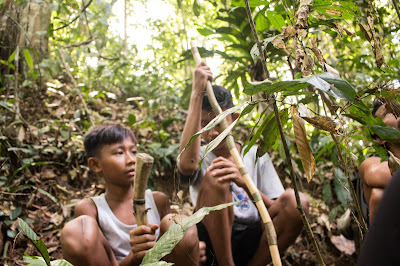The best part of this two weeks was definitely the five days we spent in the jungle, doing what? Mainly looking for wild orangutans to observe their behaviour but also to collect samples from the plants that they use in order to keep on collaborating with the research that is held in terms of their medicinal properties. and to analyse the efficacy of natural self-medicative behaviour in treating parasitic infections.

It is important to know that although our main aim is to find them, you are not guaranteed to see one in that time, so although I had all the hope, we had to be prepared for anything. Our first day started trekking through the Landak river in order to get to our camp.
We were six of us plus Wanda, Joyo and our jungle chef! After seeing the amount of weight that they were carrying on their backs, I think now one dare to even complain about our heavy backpacks. Although I tried really hard to take the least possible, there are basic stuff that you need to bring, specially when you know that you’ll probably be wet 80% of the time and that anything that is not inside a plastic bag will get wet as well. Drying in the rainforest is almost not an option, since it rains every day, humidity is very high all the time and the sun can difficultly penetrate the clouds and the dense forestation.
Our camp was in a lovely spot right by the river, at first the plan was to stay there for two nights maybe and then move, but everything was subject to change. First day after we left all of our stuff in the camp we started exploring the area going up one of the hills. The next day turned up to be, a VERY intense day. Very steep hills which made not only the way up difficult but the way down quite dangerous when they were no trees to hang on to. Although it was a great day since we got to see some very cools spots in the jungle and worked really hard to find some orangutans, we did not spot any. The good thing about it was that now one from the group was upset or negative about this fact, personally I felt very optimistic and thought it was just a matter of time.

And I was not wrong, after we got back to the camp and the sun was coming down, Wanda spotted one by chance while he was sitting on a rock on the river. Big adult male probably getting ready to go back to his nest up in the three (really high). We all left what we were doing and just sat near him and watched. Good thing was that, as it was already dusk, he would likely stay around the area and spend the night there. So early next morning we came back and he was still there. We observed him for a few hours, were lucky to actually get some fecal samples and awesome pictures thanks to Claire camera, and then left him alone to go on. It is important to know when the animal is already getting a bit uncomfortable with your presence, so it was enough for us.









PH: Mallory Abel
Having Wanda with his map of the jungle on his head has no prize. He took us one afternoon to this amazing waterfall which we obviously underestimated how hard was going to be to get there. We climbed uphill through all this wet steep rocks to get to a locations that seemed like a waterfall taken from the movie “The jungle book”.
PH: Mallory Abel
PH: Mallory Abel
PH: Mallory Abel
PH: Mallory Abel
We had already seen one wild orangutan but we wanted more, and we got more. One of the last days we were trekking through this hill and suddenly a small juvenile orangutan appeared, we thought It could be around five or six years old and Wanda told us he might have been independent for a short time. He was much more active than the other one we had seen so we could get some really cool shots of him climbing from branch to branch at an impressive height. It was the most amazing ending for one of the best weeks of my time abroad.

All of this experience would not have been the same if it wasn't for the amazing group I was lucky enough to meet. Everyone of them has something I take with me as a lesson and these kind of people is the one that make me want to improve every day and continue following my passion for wildlife and conservation.































